|
|
General: APPLE=STEVE JOBS=DA VINCI CODE=BITCOIN REVOLUTION=MARY MAGDALENE=ALCHEMY
Elegir otro panel de mensajes |
|
|
AUGUST 11TH=ST. CLARE OF ASSISI
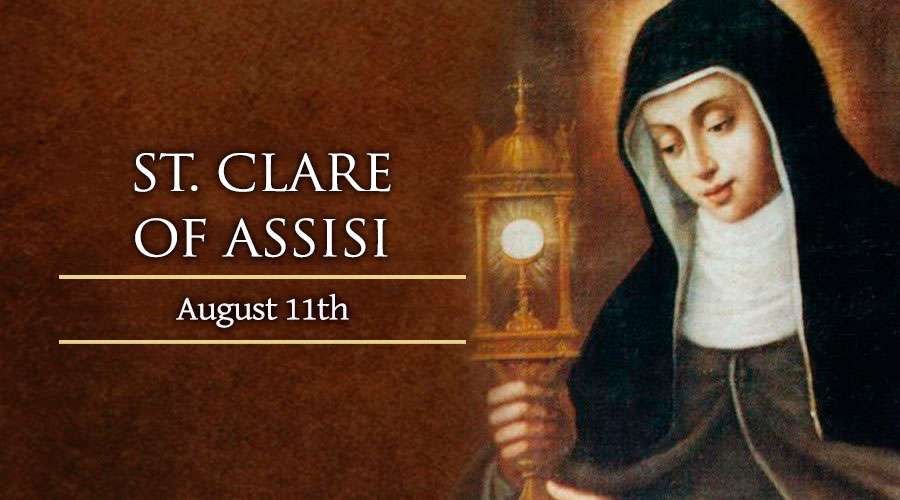
Regulus is one of the brightest stars in the night sky, which is not only the "heart of the lion" but also "prince" (or "little king") as well as "the King", just as Jupiter is named after the king of the gods. It is highly significant therefore that Regulus and Jupiter will be in "royal" conjunction on ~August 11.
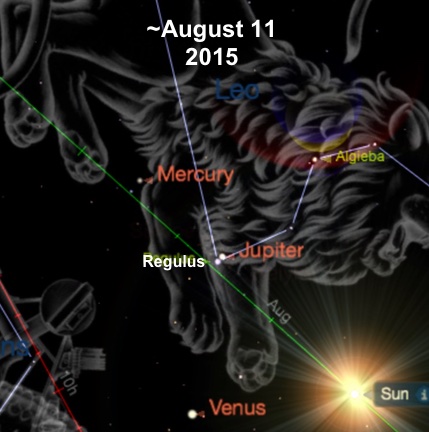
Remarkably ~August 11, 2015 is also pinpointed by a "Mayan financial crisis" time code I started highlighting back in February (STRUG) which is based on the Golden Ratio ("phi") and at least three major dates/events: 1) Transit of Venus (2004), 2) the day the US financial system almost came crashing down (9/14/2008), and 3) the "end" of the Mayan calendar (12/21/2012):
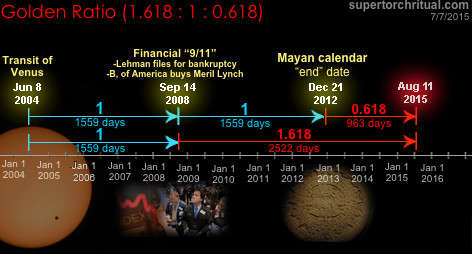

[Transit of Venus - June 8, 2004 & June 6, 2012 -
rare phenomenon of Venus passing in front of the Sun]
 Sep 14, 2008 Lehman Files for Bankruptcy; Merrill Is Sold Sep 14, 2008 Lehman Files for Bankruptcy; Merrill Is Sold
Sep 15, 2008 Crisis on Wall Street as Lehman Totters, Merrill Is Sold, AIG Seeks to Raise Cash
[Wikipedia - Global financial crisis in September 2008]
["Inside the Meltdown" (PBS) video]
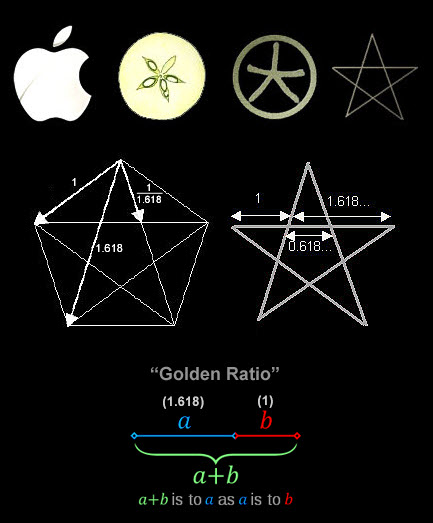
The financial crisis theme is underscored by an additional equidistant Mayan timeline coming from the May 6, 2010 "Flash Crash" (Dow Jones) pinpointing August 8, 2015, just 3 days before August 11:


[May 06, 2010 Dow freefalls almost 1,000 points, pulls back]
The point is not necessarily that we will have another such literal financial crisis in August 2015. But that we will have some notable event(s) heavily resonating with these things.
~~ UPDATE ~~
The pattern has been confirmed, as China's surprise move to devalue
its currency on August 11, 2015 destabilized global markets...
~~ END UPDATE ~~
[Original article resuming...]
On to the next set of time codes, with a temporal focus more on the latter half of August...
As I've noted many times in the past, Regulus is annually illuminated by the Sun on ~August 21–23…
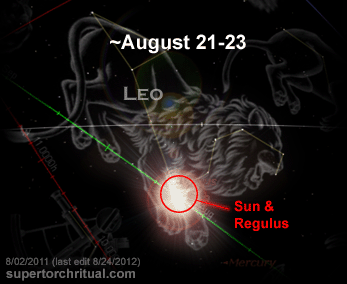
And it just so happens that it coincides with the heliacal rising of Sirius specifically at the latitude of Paris (~August 22)! But that's not all...
This year it will also coincide with Venus's rebirth as the Morning Star around August 21. (Until mid August before its inferior conjunction Venus is in its Evening Star phase.) This of course connects right back to the Transit of Venus which is a very precise form of the Venus inferior conjunction (= Earth-Venus-Sun alignment) that always immediately precedes the birth of the Morning Star.
This is very important because "Morning Star" is the original meaning of the term/name "Lucifer". And it just so happens that in the movie Lucy released in July 2014 we see Lucy's driver's license expiring specifically on "August 24, 2015".

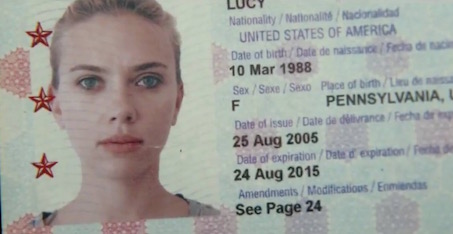
What's more, August 24 will be the anniversary of last year's big earthquake (8/24/2014) in the "phoenix city" San Francisco…

[Aug 24, 2014 Strongest quake in 25 years strikes San Francisco]

[San Francisco flag]
https://www.goroadachi.com/etemenanki/dogdays_prophecy.html
|
|
|
|
|
Pentagram pinpointing Enterprise arriving in the Big Apple...
Pentagram pinpointing Endeavour rolling through LA (and Dragon roaming the sky)...
(Note: My previous article Golden Apple highlighting the Trojan theme was posted hours before the armed conflict erupted. Pattern projection => fulfillment.) "It's all connected"...
SpaceX Marks the Spot (goroadachi.com) |
|
|
|
|
Olympics & Martian Resurrection
Babylon Baby, Grail Bloodline
& Genesis Total Recall
by Goro (goroadachi.com & supertorchritual.com)
August 03, 2012 (Updated Aug 14)

Preface
It was pretty good stuff we saw at the London Olympics Opening Ceremony on July 27. Perhaps not the most elegant opening ceremony we've seen as far as artistry and drama (that honor goes to Athens 2004), but more than adequate in terms of "whispering secrets" Enki-Prometheus style. Around here we weren't just watching, we were more actively engaged, anticipating pattern fulfillment. And boy did we ever get one!
Our multicontextual pattern assessment - most recently (re-)done in Aurora Code 2012 (July 21) - had indicated the following set of powerful themes to be in play during this period:
- Royal & Martian pregnancy/baby, Arthurian/Grail bloodline
- Intertwined issues of Mars (missions, life, panspermia, resurrection) & baby of Prince William & Kate Middleton
- Babylon/Tower of Babel
- Venus/Morning Star/Lucifer
- Sun (solar cycle, solar wind/flares/CMEs, aurora)
- And more...

If you watched the opening ceremony, you know how they turned out. Or maybe not. While some of the confirmations were fairly obvious, in your face even, like the "Tower of Babel" and the "Babylon Baby," there were other parts probably too cryptic for the average observer to discern. Especially the "Martian panspermia" segment. I am writing this article to elucidate what "really" happened at the Olympics opening ceremony, what was whispered by "Enki" from behind the wall, so everyone can get on the same page with regard to the true level of pattern fulfillment witnessed there, and what it could mean for the future. [Update: A new section discussing the closing ceremony has been added at the end of this article on August 14.]
The situation is that we have hidden patterns converging, uniting past, present and future... for a Total Recall of Martian Genesis.
Let the Games Begin.
* * *
London Olympics -
opening ceremony (July 27, 2012)
- Setting the tone right at the start of the show was the orchestral composition "Nimrod" - a dead giveaway already as Nimrod is the name of a Biblical figure who supposedly led the building of the Tower of Babel.
- Spatially anchoring the whole ceremony was a ziggurat-like hill bearing an uncanny resemblance to the Tower of Babel (officially a model of Glastonbury Tor), uniting all nations as described in the Book of Genesis.
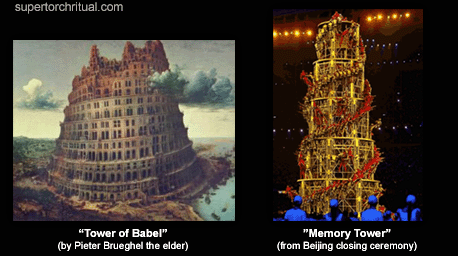

You see it, and you know it.
* * *
London Olympics -
opening ceremony (July 27, 2012)
Baby Born

- Roughly halfway into the show, a mysterious giant baby took center stage. So big, no one could possibly miss it. Talk about in your face...

- As above, so below: The same day (July 27) an unmanned Japanese spacecraft "Kounotori" arrived at the space station ISS/Isis. "Kounotori" means "White Stork" and according to tradition storks supposedly bring babies to new parents. Storks are a harbinger of childbirth. Perfect.

Jul 27 Japanese Spacecraft "Kounotori" Arrives at ISS
This of course brings to mind SpaceX Dragon's historic berthing/birthing at the ISS late May, symbolically expressing the "Birth of Horus", a subset of a larger "Transit Ritual" permeating this special year of the Mayan Apocalypse. Horus is an ancient Egyptian god identified with the rising sun, magically reflected in Japan being the "Land of the Rising Sun", i.e. "Land of Horus."
* * *
London Olympics -
opening ceremony (July 27, 2012)
Who's Your Daddy?
The shocking (not really) answer was encoded in this scene...

People coming out the "Gate of God" (= Babylon/Babel), out the Underworld... symbolic of a baby coming out of the mother's womb. Bingo...
...traditionally associated with Avalon & King Arthur.
Avalon is where King Arthur - Once and Future King - is said to be resting in hibernation, awaiting "resurrection."
"Rebirth of King Arthur", then, was the subtext of the enigmatic "Gate of God" scene. In other words, the giant baby was suggested to be of the Grail Bloodline, semi-historically linked to the British Royal Family... more so on the Diana/Jacobite succession side, the side of Prince William, Kate and their presumably upcoming baby. So the Giant Baby, at least on the terrestrial level, directly or indirectly had to do with William & Kate, i.e. their baby. This matches what we've been projecting for 2012-2013.
- Avalon means "apple," implying "pentagram," signifying a gateway to the Underworld, the realm of the "underground stream" (Grail bloodline).
- The king of the dead in the Underworld is Osiris, who becomes his son Horus through resurrection via the Duat's pentagrammic interdimensional portal.
- A group called "Underworld" was in charge of music for the opening ceremony.
- Opening ceremony (July 27) was pinpointed by one of the apexes of a pentagram inscribed inside the Earth's orbit.

Olympics & Martian Resurrection (goroadachi.com) |
|
|
|
|
Contact via Earthquakes
Pentagonal Stargate Activation 2010
February 27, 2010
by Goro (supertorchritual.com & goroadachi.com)



Enki works in mysterious ways. He sees the angles. He sees the alignments. He understands space. He understands time. It's '2010' and he comes in peace. Contact via earthquakes... This is it. This is how it begins...
Haiti - Chile Alignment...

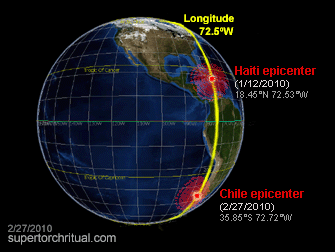

Behold, the Earth-Shaker opens the Pentagonal Stargate...


The pentagram is the symbol of Venus. Venus is the goddess/planet of love. Love in many languages is amor. Amor is the reverse of Roma. As they say, all roads lead to Rome. Even the pentagram. The Pentagonal Contact Sequence started back on April 6, 2009 near Rome...


Orbitally reversed and it becomes Megafault starring Brittany Murphy (who had an Italian father linked to the mob)...

...whose untimely death marked the winter solstice 2009 at the apex of the pentagonal 'V' apex.
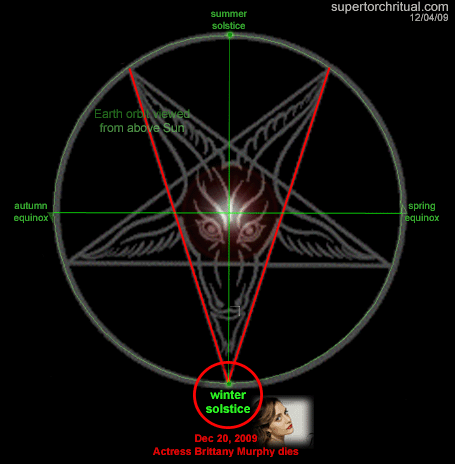
'Vs' of course come in peace...


...through a Pentagonal Stargate

...and an earthquake.

'Knee' = Rome in leg-shaped Italy...

'Ring' = Pacific (= 'peace') Ring of Fire...
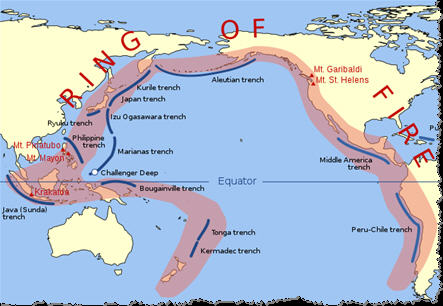
Chile is in the Ring of Peace/'V'...
And 'V' is balloons...

...reenacted right before the 'V' premiere (Nov 3, 2009)
via Balloon Boy on Oct 15...


...which was orbitally 'stereo aligned' with Feb 25-26,
or the Chile 'Big One' (Feb 27).

Contact via earthquakes = Contact with V = Contact with Peace = Contact with Love (Rome, Venus) = Contact via Pentagram
All in the 'Big One' space-time geometric overlay...

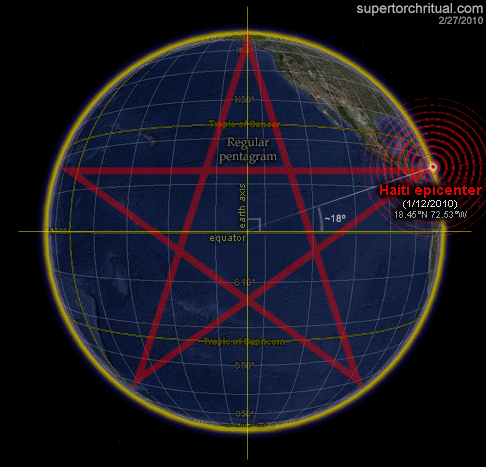

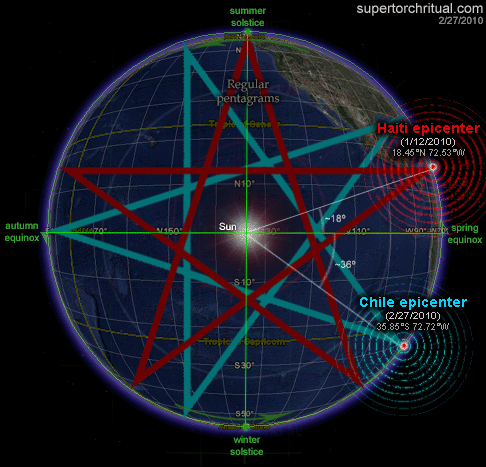

And that's how Contact is being made in 2010.
Just the tip of the iceberg.
* * *
NOTE: For those new here, please note that this strange thing that I do on this website is not the typical hindsight-driven dot connecting stuff that you may have seen out there. Here, much emphasis is placed on foresight. I regularly make predictions or multicontextual pattern projections to demonstrate that it is something very real - albeit 'impossible' according to the current paradigm - that I discuss and try to show again and again. So, for instance, even though I decided not to bring it up in the main text of the article purely for readabililty, both the April 2009 Italian earthquake and the January 2010 Haiti 'Big One' were, to a considerable degree, projected beforehand. (See here & here - the latter not including STRUG entries thus appearing less impressive than what was actually going on 'underground' projection-wise.) Even the latest Chile mega-quake was no surprise around here (especially on STRUG) - evidenced by the fact that I was able to quickly write up and post this article within 24 hours of the catastrophe. For many months, in fact, I kept highlighting the Vancouver Olympics (Feb 12-28) and its general timeframe, based on various patterns, in particular the following golden/phi-based timecode which had 'Big One' (mega-quake) written all over it.

Not surprisingly, there was to be further twists which I was able to closely follow, leading me to make a necessary adjustment just in time for (i.e. before) the early-January quakes including Haiti. (I haven't yet fully explained what caused me to make the adjustment but that it was a valid move is obviously not in question.) After Haiti, the status of the February 2010 window became uncertain - was it still radioactive or had it released all its energy in January? We now know the answer: Another small time shift, another 'Big One' (this time in Chile), coming the day before the closing ceremony of the 'V Olympics' instead of the opening ceremony. And it was decidedly pentagonal in nature. This is important because in addition to what's already been discussed the pentagram is nearly synonymous with (i.e. found encoded in its geometry) the golden ratio, i.e. '1 : 1.618', therefore linking back to the phi-based timecode above.

* * *
To be continued...
https://www.goroadachi.com/etemenanki/contact-penta-quakes.htm
|
|
|
|
|
|
SANTA CLARA (AUGUST 11TH)=RAMADAN 2010 |
|
|
 Primer Primer
 Anterior
64 a 78 de 78
Siguiente Anterior
64 a 78 de 78
Siguiente
 Último
Último

|
|
| |
|
|
©2026 - Gabitos - Todos los derechos reservados | |
|
|

